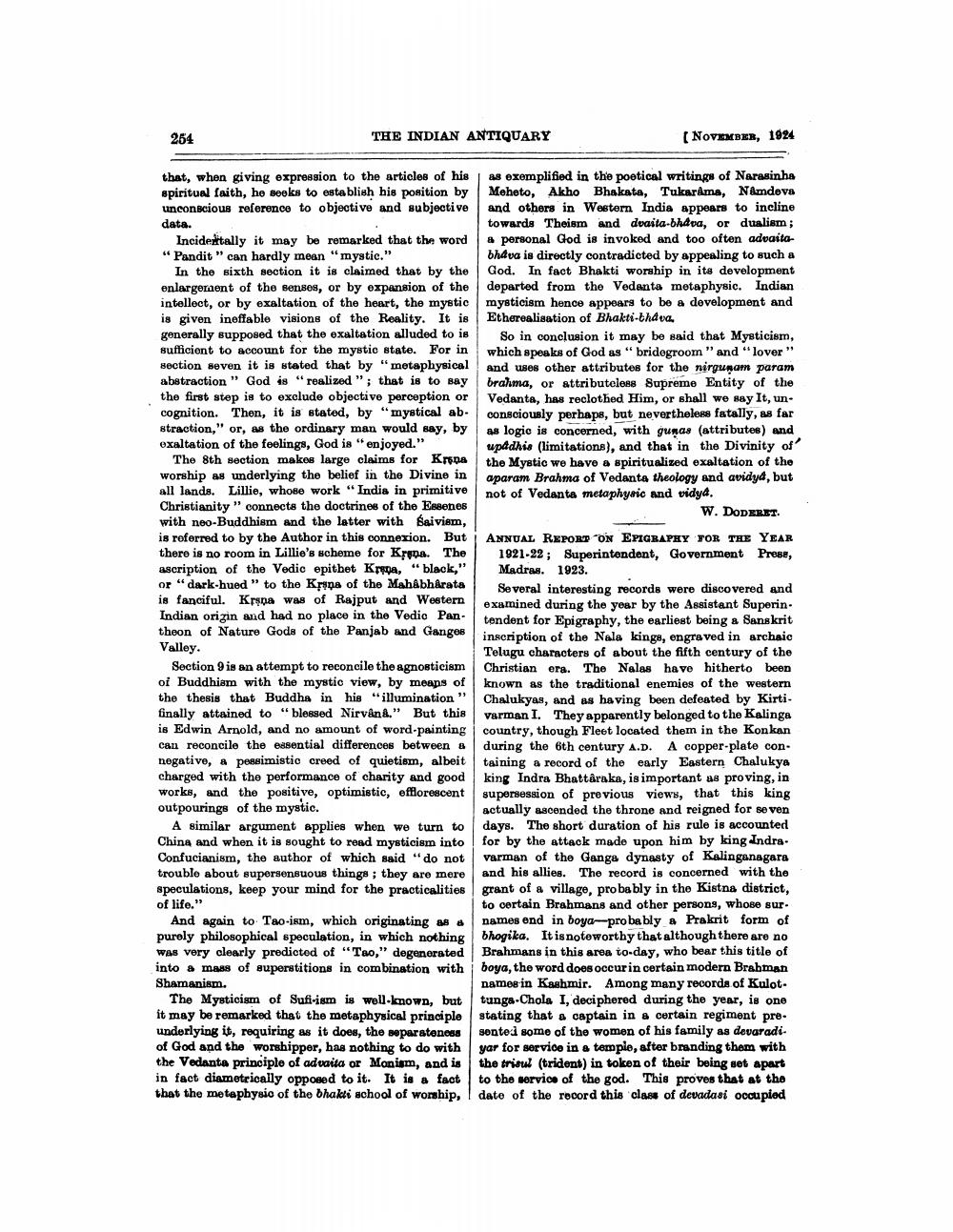________________
264
THE INDIAN ANTIQUARY
( NOVEMBER, 1924
that, when giving expression to the articles of his as exemplified in the poetical writings of Narasinha spiritual faith, he seeks to establish his position by Meheto, Akho Bhakata, Tukarma, Namdova unconscious reference to objective and subjective and others in Western India appears to incline data.
towards Theism and dvaita-bhdva, or dualism; Incidentally it may be remarked that the word # personal God is invoked and too often advaita“Pandit " can hardly mean "mystic."
bhava is directly contradicted by appealing to such a In the sixth section it is claimed that by the God. In fact Bhakti worship in its development enlargeraent of the senses, or by expansion of the departed from the Vedanta metaphysic. Indian intellect, or by exaltation of the heart, the mystic mysticism hence appears to be a development and is given ineffable visions of the Reality. It is Etherealisation of Bhakti-thaven generally supposed that the exaltation alluded to is
So in conclusion it may be said that Mysticism, sufficiont to account for the mystio state. For in which speaks of God as "bridegroom" and lover section seven it is stated that by "metaphysical and uses other attributes for the nirgunam param abstraction " God is "realized "; that is to say brahma, or attributeless Supreme Entity of the the first step is to exclude objective perception or Vedanta, has reclothed Him, or shall we say It, uncognition. Then, it is stated, by "mystical ab. consciously perhaps, but nevertheless fatally, as far straction," or, as the ordinary man would say, by as logic is concerned, with gunas (attributes) and exaltation of the feelings, God is "enjoyed."
upddhis (limitations), and that in the Divinity of The 8th section makes large claims for Krona
the Mystic we have a spiritualized exaltation of the worship as underlying the belief in the Divine in
aparam Brahma of Vedanta theology and avidyd, but all lands. Lillie, whose work "India in primitive
not of Vedanta metaphysic and vidya. Christianity" connects the doctrines of the Essenes
W. DODERET. with neo-Buddhism and the latter with Saiviem, is roferred to by the Author in this connexion. But | ANNUAL REPORT ON EPIGRAPHY FOR THE YEAR there is no room in Lillie's scheme for Krypa. The 1921-22; Superintendent, Government Prese, ascription of the Vedic epithet Kra,“black," Madras. 1923. or "dark-hued " to the Krena of the Mahabharata
Several interesting records were discovered and is fanciful. Krsna was of Rajput and Western
examined during the year by the Assistant Superin. Indian origin and had no place in the Vedic Pan.
tendent for Epigraphy, the earliest being a Sanskrit theon of Nature Gods of the Panjab and Ganges
inscription of the Nala kinga, engraved in archaic Valley.
Telugu characters of about the fifth century of the Section 9 is an attempt to reconcile the agnosticism Christian era. The Nalas have hitherto been of Buddhism with the mystic view, by means of known as the traditional enemies of the western the thesis that Buddha in his "illumination" Chalukyas, and as having been defeated by Kirti. finally attained to "blessed Nirvana." But this varman I. They apparently belonged to the Kalinga is Edwin Arnold, and no amount of word-painting country, though Fleet located them in the Konkan can reconcile the essential differences between a during the 6th century A.D. A copper-plate con negative, a pessimistic creed of quietism, albeit taining a record of the early Eastern Chalukya charged with the performance of charity and good king Indra Bhattaraka, is important as proving, in works, and the positive, optimistic, efflorescent supersession of previous views, that this king outpourings of the mystic.
actually ascended the throne and reigned for seven A similar argument applies when we turn to days. The short duration of his rue 18 accounted China and when it is sought to read mysticism into for by the attack made upon him by king Indra. Confucianism, the author of which said "do not varman of the Ganga dynasty of Kalinganagara trouble about supersensuous things; they are mere and his allies. The record is concerned with the speculations, keep your mind for the practicalities grant of a village, probably in the Kistna district, of life."
to certain Brahmans and other persons, whose sur And again to Tao-ism, which originating as a names end in boya--probably a Prakrit form of purely philosophical speculation, in which nothing bhogika. It is noteworthy that although there are no Was very clearly predictod of "Too," degenerated Brahmans in this area to day, who bear this title of into a mass of superstitions in combination with boya, the word does occur in certain modern Brahman Shamanism.
names in Kashmir. Among many records of Kulot. The Mysticism of Sufi-ism is well-known, but tunga-Chola I, deciphered during the year, is one it may be remarked that the metaphysical principle stating that a captain in a certain regiment preunderlying it, requiring as it does, the separateness sonted some of the women of his family as devaradi. of God and the worshipper, has nothing to do with yar for service in a temple, after branding them with the Vedanta principle of advaita or Moniam, and is the trisul (trident) in token of their being set apart in fact diametrically opposed to it. It is a fact to the service of the god. This proves that at the that the metaphysic of the bhakti school of Worship, I date of the record this class of devadasi occupied




